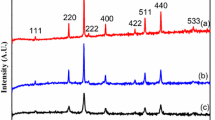Abstract
Sol–gel auto combustion process was employed to synthesize nanosized Mn–Zn ferrite at different pH values (<1, 5, 6, 7, 8 and 10). Although self propagating combustion behavior of gel was noted at pH 5 but more effective combustion was observed at pH 6. The smoldering effect was observed in gel prepared at pH 7, 8 and 10, whereas pH < 1 showed localized burning. Thermogravimetric (TG) and X-ray diffraction (XRD) analyses were done to investigate the effect of pH on the combustion behavior, particle size and the formation of desired magnetic (spinel) phase. From TG curves of burnt powders, activation energy of ignition reaction at each pH value was calculated. The results showed that fuel to oxidant ratio and the amount of gel residuals decided the value of activation energy required to further purify the burnt powders. Calcination parameters (time and temperature in air) of powders P1 and P6 synthesized at pH < 1 and pH 6 were also determined. B–H loop results showed that calcined powder C6 was more ferromagnetic than C1 due to fully developed spinel phase and larger particle size.










Similar content being viewed by others
References
Arulmurugan R, Vaidyanathan G, Sendhilnathan S, Jeyadevan B. Mn–Zn ferrite nanoparticles for ferrofluid preparation: study on thermal–magnetic properties. J Magn Mag Mater. 2006;298:83–94.
Levy D, Hoser A. Cation distribution in synthetic zinc ferrite (Zn0.97Fe2.02O4) from in situ high-temperature neutron powder diffraction. Am Mineral. 2000;85:1497–502.
Tangsali RB, Keluskar SH, Niak GK, Budkuley JS. Effect of sintering conditions on resistivity of nanoparticle Mn–Zn ferrite prepared by nitrilotriacetate precursor method. J Mater Sci. 2007;42:878–82.
Ahns SJ, Yoon CS, Yoon SG, Kim CK, Byun TY, Hong KS. Domain structure of polycrystalline MnZn ferrites. Mater Sci Eng B. 2001;84:146–54.
Parekh K, Upadhyay RV, Belova L. Ternary monodispersed Mn0.5Zn0.5Fe2O4 ferrite nanoparticles: preparation and magnetic characterization. Nanotechnology. 2006;17:5970–5.
Botta PM, Bercoff PG, Aglietti EF, Bertorello HR, Lopez JMP. Two alternative synthesis routes for Mn–Zn ferrites using mechanochemical treatments. Ceram Inter. 2006;32:857–63.
Rosales MI, Plata AM, Nicho ME, Brito A, Ponce MA. Effect of sintering conditions on microstructure and magnetic properties of Mn–Zn ferrites. J Mater Sci. 1995;30:4446–50.
Ding J, McCormick PG, Street R. Formation of spinel Mn–ferrite during mechanical alloying. J Magn Mag Mater. 1997;171:309–14.
Qureshi AH. The influence of hafnia and impurities (CaO/SiO2) on the microstructure and magnetic properties of Mn–Zn ferrites. J Cryst Growth. 2006;286:365–70.
Azadmanjiri J. Preparation of Mn–Zn ferrite nanoparticles from chemical sol–gel combustion method and the magnetic properties after sintering. J Non Cryst Solids. 2007;353:4170−3.
Mandal K, Mandal SP, Agudo P, Pal M. A study of nanocrystalline (Mn–Zn) ferrite in SiO2 matrix. Appl Surf Sci. 2001;182:386–9.
Azadmanjiri J, Seyyed Ebrahimi SA. The effect of pH and citric acid concentration on the characterization of nanocrystalline NiFe2O4 powder synthesized by a sol–gel autocombustion method. Phys Metals Metallogr. 2006;102:S21–3.
Azadmanjiri J, Salehani HK, Barati MR, Farzan F. Preparation and electromagnetic properties of Ni1−xCuxFe2O4 nanoparticle ferrites by sol–gel auto-combustion method. Mater Lett. 2007;61:84–7.
Zhang ZJ, Wang ZL, Chakoumakos BC, Yin JS. Temperature dependence of cation distribution and oxidation state in magnetic Mn−Fe ferrite. J Am Chem Soc. 1998;120:1800–4.
Wang H, Kung S. Crystallization of nanosized Ni–Zn ferrite powders prepared by hydrothermal method. J Magn Mag Mater. 2004;270:230–6.
Wang XH, Li XJ, Yan HH, Qu YD, Sun GL, Xie XH, et al. Research on thermal decomposition kinetic characteristic of emulsion explosive base containing Fe and Mn elements. J Therm Anal Calorim. 2008;91:545–50.
Rane KS, Uskaikar H, Pednekar R, Mhalsikar R. The low temperature synthesis of metal oxides by novel hydrazine method. J Therm Anal Calorim. 2007;90:627–38.
Xavier CS, Candeia RA, Bernardi MIB, Lima SJG, Longo E, Paskocimas CA, et al. Effect of the modifier ion on the properties of MgFe2O4 and ZnFe2O4 pigments. J Therm Anal Calorim. 2007;87:709–13.
Silva MRS, De Miranda LCO, Cassia-Santos MR, Lima SJG, Soledade LEB, Longo E, et al. Influence of the network former on the properties of magnesium spinels. J Therm Anal Calorim. 2007;87:753–7.
Horowitz HH, Metzger G. A new analysis of thermogravimetric traces. Anal Chem. 1963;35:1465–8.
Zyrichev NA, Shlenskii OF. Kinetics of decomposition of hydrated nitrates by short contact time plasma heating. High Energy Chem. 2000;34:46–52.
Singh G, Singh CP, Frohlich R. Preparation, characterization and thermolysis of metal nitrate complexes with 4,4′-bipyridine. J Therm Anal Calorim. 2006;85:425–31.
Singh G, Baranwal BP, Kapoor IPS, Kumar D, Singh CP, Frohlich R. Transition metal nitrate complexes with hexamethylenetetramine. J Therm Anal Calorim. 2008;91:971–7.
Qureshi AH, Arshad M, Durrani SK, Waqas H. Impact of Pb substitution on the formation of high Tc superconducting phase in BSCCO system derived through sol–gel process. J Therm Anal Calorim. 2008;94:175–80.
Tomar MS, Singh SP, Perez OP, Guzman RP, Calderonc E, Ramo CR. Microelectron synthesis and magnetic behavior of nanostructured ferrites for spintronics. Microelectron J. 2005;36:475–9.
Makovec D, Kodre EA, Arcon I, Drofenik M. Non-stoichiometric zinc–ferrite spinel nanoparticles. J Nanopart Res. 2008;10:131–41.
Acknowledgements
Authors would like to thank Pakistan Higher Education Commission (HEC) for providing financial assistance.
Author information
Authors and Affiliations
Corresponding author
Rights and permissions
About this article
Cite this article
Waqas, H., Qureshi, A.H. Influence of pH on nanosized Mn–Zn ferrite synthesized by sol–gel auto combustion process. J Therm Anal Calorim 98, 355–360 (2009). https://doi.org/10.1007/s10973-009-0289-8
Received:
Accepted:
Published:
Issue Date:
DOI: https://doi.org/10.1007/s10973-009-0289-8




